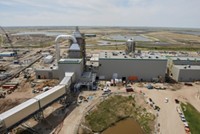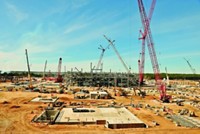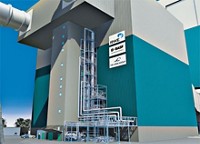Advertisement
Grab your lab coat. Let's get started
Welcome!
Welcome!
Create an account below to get 6 C&EN articles per month, receive newsletters and more - all free.
It seems this is your first time logging in online. Please enter the following information to continue.
As an ACS member you automatically get access to this site. All we need is few more details to create your reading experience.
Not you? Sign in with a different account.
Not you? Sign in with a different account.
ERROR 1
ERROR 1
ERROR 2
ERROR 2
ERROR 2
ERROR 2
ERROR 2
Password and Confirm password must match.
If you have an ACS member number, please enter it here so we can link this account to your membership. (optional)
ERROR 2
ACS values your privacy. By submitting your information, you are gaining access to C&EN and subscribing to our weekly newsletter. We use the information you provide to make your reading experience better, and we will never sell your data to third party members.
Business
Lurching Toward Low-Pollution Coal Power
Chemical technologies promise to lower utility emissions and keep coal competitive with natural gas
by Marc S. Reisch
November 19, 2012
| A version of this story appeared in
Volume 90, Issue 47

With the U.S. elections over, it is clear that four more years of President Barack Obama’s Administration will mean no letup in the Environmental Protection Agency’s efforts to lower emissions from coal-fired power plants. Add to that today’s low prices for natural gas, and it is also clear that coal is no longer king.
COVER STORY
Coal’s Enduring Power
Between the comparatively high cost of implementing emission controls and the low cost to build and fuel gas-fired generating plants, older coal-fired power plants will undoubtedly be shut down. And because of uncertainty about what regulations will be put in place in the future, utilities are holding back on building new coal plants to replace the old ones.
Yet almost 40% of the country’s electricity is generated from coal, and that’s not going to change overnight. Moreover, utility executives don’t want to become dependent on any particular fuel—especially a fuel such as natural gas, which is subject to wide fluctuations in price and availability.
But for coal to pass muster with the Obama Administration, it will have to burn cleaner than ever before. Lining up to help the power industry achieve this goal is a bevy of companies that say chemistry-based technologies are the answer. However, many of these firms’ techniques are still in the early proof-of-concept phase. They need to convince their potential customers that the technologies can reduce emissions cheaply to keep coal competitive with natural gas.
Among the new regulations the power industry must contend with are the Mercury & Air Toxics (MAT) standards. Set to go into effect in 2014, the standards will limit emissions of mercury, sulfur dioxide (SO2), nitrogen oxides (NOx), and other contaminants. They will affect 1,100 coal-burning power plants.
Francisco C. de la Chesnaye, one of the authors of a recent study on technology options for coal published by the utility-supported Electric Power Research Institute, estimates that the cost to retrofit an average 400-MW bituminous-coal-burning power plant to meet the 2014 EPA rules is $750 million. The estimate does not include carbon dioxide mitigation rules, which have yet to be ironed out.
“Regulations are a wild card, and they are driving a lot of uncertainties,” de la Chesnaye says. Other variables in estimating the costs to meet new regulations include the age and design of specific plants. If retrofit costs can be kept low, about 40 gigawatts of the existing 300 GW of U.S. coal power generation could go off-line by 2020. However, if retrofit prices come in at the high end, about 60 GW of capacity could be shuttered.
But U.S. natural gas prices are now at a longtime low of about $3.45 per million Btu because of drilling technology based on hydraulic fracturing. The abundant new source of gas could have a greater impact than technology costs on the coal utility industry, according to de la Chesnaye’s study. If gas prices stay below $4.50 per million Btu, as much as 100 GW of U.S. coal power generation could go off-line by 2020. But if gas prices go to $8.50 per million Btu, just 25 GW could disappear.

In coal’s favor as a long-term viable fuel is its consistent low cost, currently about $2.40 per million Btu. In many other parts of the world, natural gas prices are not as low as in the U.S., and coal is abundant and low cost, points out Robert McIlvaine, president of the consulting firm McIlvaine Co.
McIlvaine is bullish on coal, which supplies 40% of the world’s electricity. He is also bullish on the opportunity to provide emissions control technology. He anticipates global sales of mercury reduction hardware and consumables to grow from less than $200 million this year to $1 billion by 2022. Systems to cut SO2 will grow from $9 billion to $12 billion, McIlvaine notes.
Conventional controls plus CO2 capture technology could make coal a “greener” energy source than shale-derived natural gas, McIlvaine says. The injection of CO2 from coal-burning utilities into oil wells to enhance oil recovery can reduce emissions of the greenhouse gas to levels comparable to those of gas-fired power plants, he argues. Taking a further step to equip coal plants with high-efficiency boilers that burn 80% coal and 20% biomass could actually reduce CO2 in the atmosphere, McIlvaine says.
At Johnson Matthey Catalysts, a supplier of selective catalytic reduction technologies to reduce emissions of NOx, President Cindy R. Khalaf also contends that coal will remain competitive. “The day will come when natural gas will be exported from the U.S., and it will be a worldwide commodity like coal. Then gas prices will likely be higher,” she says. Transporting liquefied natural gas is feasible but is not now done in large quantities.
In the meantime, Khalaf figures that conversion of coal-fired power plants to run on natural gas is unlikely to happen in large numbers. The cost of bringing a gas pipeline to a coal plant is between $1 million and $3 million per mile. “That is a big capital hurdle to conversion,” she says.
Undoubtedly, the current abundance of gas from shale puts coal under pressure, says Anders N. Olsen, chief executive officer of the U.S. subsidiary of catalysis expert Haldor Topsøe. But in the U.S., “coal is too big a part of today’s energy mix to abandon overnight,” he argues.
Haldor Topsøe, a Denmark-based supplier of power plant catalyst technology, sees an opportunity to turn emissions of the smog precursor SO2 into industrial chemical sulfuric acid rather than low-value calcium sulfate, as is done today. Olsen says the firm’s SNOX-ESAP technology allows power companies to use low-cost, high-sulfur coal by producing and selling sulfuric acid.
Mercury emissions are another key target of EPA’s MAT rules, which require capture of up to 90% of mercury from the worst-performing plants. Anticipating the rules, chemical companies such as Calgon Carbon, Albemarle, and Norit started five years ago to commercialize mercury reduction technologies based largely on activated carbon.
Denver-based start-up Novinda is tackling mercury removal with an amended silicate system. The silicate is loaded with proprietary metal chemistry, says Jay S. Crilley, vice president of sales, allowing the mercury to be captured along with ash in a coal-burning plant’s particulate capture system.
Crilley says the gas boom won’t end coal-burning power plants. Gas prices tend to go up and down, he points out. “We’ve been through this before.”
Coal-dependent utilities are addressing stricter environmental rules by investing in clean-coal furnace technology. For example, Southern Co., an Atlanta-based electric utility, has teamed up with engineering firm KBR, based in Houston, to develop what they call transport integration gasification (TRIG) technology.
Adapted from fluid catalytic cracking technology, which is used to refine petroleum into gasoline and olefins, TRIG converts coal into a synthesis gas that competes with natural gas in terms of price, according to Southern. KBR is a major developer of fluid catalytic cracking technology.
The two companies say TRIG-driven plants can use low-cost lignite and sub-bituminous coal to generate power and can capture 65% of CO2 produced for commercial use. TRIG plants are expected to emit about the same amount of CO2 as a similarly sized gas-burning power plant.

Using the technology, developed with funding from the Department of Energy, Southern is building a 582-MW TRIG unit in Kemper County, Miss., that is scheduled to open in 2014. Southern plans to sell the CO2 captured in the process for enhanced oil recovery. The plant will also sell ammonia and sulfuric acid produced from NOx and SO2 removed from flue gas.
KBR and Southern have already licensed TRIG to Dongguan Tianming Electric Power for a coal-fired power plant under construction in China. And the firms expect other licensees in markets where coal is available and natural gas prices are relatively high.
“China alone is expected to add more than 300,000 MW of new coal-based generating capacity by 2035,” a Southern spokesman says. “India and other parts of Asia are projected to add more than 100,000 MW in that same time frame.” Both countries have large coal resources.
High-efficiency furnace technology like the TRIG process is technologically proven, says David J. Walls, managing director at consulting firm Navigant. But the industry needs to build several such plants to learn how to lower the costs of the new technology.
However, at least in the U.S., it is now difficult to finance new coal-burning power plants. Regulatory challenges present large hurdles, and “the economics of gas-based combined-cycle power generation” make that process trump other ways to generate electric power, Walls says.
The challenge going forward is for clean coal to demonstrate its value among various energy options, including nuclear power, Walls says. Despite concerns raised over nuclear power by the radiation leak at the Fukushima Daiichi nuclear plant in Japan after the 2011 tsunami, China recently lifted its moratorium on new nuclear plants, and Japan is allowing new plants approved before the leak to be built, he says. The U.S. continues to consider nuclear energy a viable option.

Although the MAT rules don’t address CO2 emissions, utilities realize that CO2 is on EPA’s hit list. Globally, utilities are also wrestling with climate-change regulations. Anticipating future regulations, Southern last year successfully started up a carbon capture demonstration unit built by Mitsubishi Heavy Industries at Southern’s Plant Barry power facility in Alabama.
According to Mitsubishi, the process relies on a hindered amine solvent to capture 90% of CO2 emissions. In amine-based CO2 capture processes, flue gas is run through an amine solution that absorbs CO2. Subsequent heating strips out the gas for compression and transport.
Some coal plant operators believe emission control costs for CO2 and other pollutants can be offset by converting the compounds to valuable chemicals. One is SaskPower, a Canadian utility that plans to start up a coal-fired power plant designed with state-of-the-art SO2, NOx, and carbon capture controls.
The company acknowledges that the 110-MW plant, called Boundary Dam Unit 3, will produce electricity at higher cost than two adjacent coal-burning units at the western Canada site. However, electricity costs will be “competitive with new natural gas combined-cycle generation,” a SaskPower spokesman says. Revenue from sales of CO2, sulfuric acid, and coal fly ash “will help offset higher generating costs.”
As at the Southern unit in Alabama, the Boundary Dam Unit 3 plant will use an amine-based solvent to capture CO2.SaskPower is using technology from Shell subsidiary Cansolv Technologies that was first developed to remove SO2 from sulfuric acid plant flue gas. Cansolv later adapted the process for CO2 removal, and SaskPower will use it for both purposes.

Others are working on similar carbon capture technology. BASF received a $2 million DOE grant in 2010 to develop a nonaqueous amine solvent system; BASF’s partner in the project is RTI International, a North Carolina-based research organization. BASF says the system could lower carbon capture costs to 40% below conventional amine-based processes.
In Germany, where the government plans to shutter nuclear power plants by 2022, coal-fired plants are slated to take up some of the slack. BASF has partnered with power generator RWE and industrial gas firm Linde to perfect carbon capture. They have a pilot CO2 scrubbing plant in Niederaussem and say they expect their amine-based technology to be commercially viable by 2020.
CO2 Solutions, a spin-off from Canada’s Laval University, also aims to develop an amine-based sorbent that can lower carbon capture costs by 40% or more, says CEO Glenn R. Kelly. The firm has patented an enzyme, carbonic anhydrase, that boosts the efficiency of amine-based sorbents.
Carbonic anhydrase, Kelly explains, is the same enzyme that manages the human respiratory process. When added to an amine-based solvent, the enzyme creates an “industrial lung” capable of repeatedly absorbing and releasing CO2.
The firm has worked with enzyme specialist Codexis, which owns 13% of CO2 Solutions, to improve the enzyme’s performance for carbon capture. The technology is still a few years away from commercialization. Codexis demonstrated proof of concept during a test run earlier this year at DOE’s National Carbon Capture Center in Wilsonville, Ala.
Advertisement
Also under development are dry sorbents to capture carbon. Michael Durham, CEO of ADA Environmental Solutions, says his firm is evaluating high-surface-area solid particles loaded with amines and other sorbents as a way to reduce the energy needed for carbon capture. Using $3.2 million in funding from DOE, the Electric Power Research Institute, and several utilities, ADA hopes to have a commercial product by 2020.
To keep the lights turned on, utilities want to avoid relying on any one fuel source, says Walls, the Navigant consultant. The “real value of coal is the reliability of fuel supply.” Weeks of coal can be stored on-site. “You can’t do that with natural gas,” he says.
Indeed, utilities like Southern and SaskPower have an important reason to encourage efforts by chemical companies to improve emission control technologies. They want to preserve coal, an abundant energy resource, as a fuel option well into the future.





Join the conversation
Contact the reporter
Submit a Letter to the Editor for publication
Engage with us on Twitter